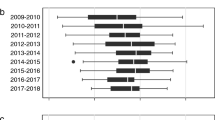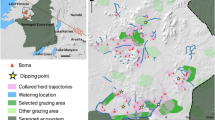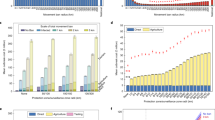Abstract
For 20 years, bovine tuberculosis (BTB) has been spreading in Great Britain (England, Wales and Scotland) and is now endemic in the southwest and parts of central England and in southwest Wales, and occurs sporadically elsewhere. Although its transmission pathways remain poorly understood, the disease's distribution was previously modelled statistically by using environmental variables and measures of their seasonality1. Movements of infected animals have long been considered a critical factor in the spread of livestock diseases, as reflected in strict import/export regulations, the extensive movement restrictions imposed during the 2001 foot-and-mouth disease outbreak2,3, the tracing procedures after a new case of BTB has been confirmed and the Government's recently published strategic framework for the sustainable control on BTB4. Since January 2001 it has been mandatory for stock-keepers in Great Britain to notify the British Cattle Movement Service of all cattle births, movements and deaths5. Here we show that movements as recorded in the Cattle Tracing System data archive, and particularly those from areas where BTB is reported, consistently outperform environmental, topographic and other anthropogenic variables as the main predictor of disease occurrence. Simulation distribution models for 2002 and 2003, incorporating all predictor categories, are presented and used to project distributions for 2004 and 2005.
This is a preview of subscription content, access via your institution
Access options
Subscribe to this journal
Receive 51 print issues and online access
$199.00 per year
only $3.90 per issue
Buy this article
- Purchase on Springer Link
- Instant access to full article PDF
Prices may be subject to local taxes which are calculated during checkout



Similar content being viewed by others
References
Wint, G. R. et al. Mapping bovine tuberculosis in Great Britain using environmental data. Trends Microbiol. 10, 441–444 (2002)
Gibbens, J. C. et al. Descriptive epidemiology of the 2001 foot and mouth disease epidemic in Great Britain: The first five months. Vet. Rec. 149, 729–743 (2001)
Haydon, D. T. et al. The construction and analysis of epidemic trees with reference to the 2001 UK foot-and-mouth disease outbreak. Proc. R. Soc. Lond. B 270, 121–127 (2003)
DEFRA. Government Strategic Framework for the Sustainable Control of Bovine Truberculosis (bTB) in Great Britain March (Department for Environment, Food and Rural Affairs, London, 2005)
NAO. Identifying and Tracking Livestock in England (Stationery Office, on behalf of National Audit Office, London, 2003)
Bourne, F. J. et al. An Epidemiological Investigation into Bovine Tuberculosis—Towards a Sustainable Policy to Control TB in Cattle (Department for Environment, Food and Rural Affairs, London, 2001)
Krebs, J. et al. Bovine Tuberculosis in Cattle and Badgers (Ministry of Agriculture, Fisheries and Food Publications, London, 1997)
Donnelly, C. A. et al. Impact of localized badger culling on tuberculosis incidence in British cattle. Nature 426, 834–837 (2003)
Hay, S. I. & Lennon, J. J. Deriving meteorological variables across Africa for the study and control of vector-borne disease: a comparison of remote sensing and spatial interpolation of climate. Trop. Med. Int. Health 4, 58–71 (1999)
Hay, S. I., Randolph, S. E. & Rogers, D. J. (eds) Remote Sensing and Geographical Information Systems in Epidemiology (Advances in Parasitology Vol. 47) (Academic, London, 2000)
Hengeveld, R. Dynamics of Biological Invasions (Chapman & Hall, London, 1989)
Shigesada, N. & Kawasaki, K. Biological Invasions: Theory and Practices (Oxford Univ. Press, Oxford, 1997)
Gilbert, M., Grégoire, J.-C., Freise, J. & Heitland, W. Long-distance dispersal and human population density allow the prediction of invasive patterns in the horse-chestnut leafminer Cameraria ohridella. J. Anim. Ecol. 73, 459–468 (2004)
Mitchell, A. et al. Characteristics of cattle movements in Britain—an analysis of records from the Cattle Tracing Scheme. J. Anim. Sci. 80, 265–273 (2005)
Congalton, R. G. A review of assessing the accuracy of classifications of remotely sensed data. Remote Sens. Environ. 37, 35–46 (1991)
Smith, D. L., Lucey, B., Waller, L. A., Childs, J. E. & Real, L. A. Predicting the spatial dynamics of rabies epidemics on heterogeneous landscapes. Proc. Natl. Acad. Sci. USA 99, 3668–3672 (2002)
Russell, C. A., Smith, D. L., Waller, L. A., Childs, J. E. & Real, L. A. A priori prediction of disease invasion dynamics in a novel environment. Proc. R. Soc. Lond. B 271, 21–25 (2004)
Acknowledgements
We thank D. Cox for comments on an early draft of the paper; D. Rogers and his TALA Research Group at Oxford for advice and for providing satellite imagery; and P. Roeder for help and encouragement. This work was funded by a DEFRA research project.Author Contributions M.G. did the simulation modelling and spatial statistics. W.W. did the data management, analysis and regression modelling. A.M. and J.M. did the movement data acquisition, processing and analysis. D.B. and R.C.-H. did the interpretation, editing and project management. A.M., J.M. and R.C.-H. are Civil Servants and as such their work is subject to Crown Copyright.
Author information
Authors and Affiliations
Corresponding author
Ethics declarations
Competing interests
Reprints and permissions information is available at npg.nature.com/reprintsandpermissions. The authors declare no competing financial interests.
Supplementary information
Supplementary Information
This file contains Supplementary Data, Supplementary Methods, four Supplementary Video legends, three Supplementary Figures, six Supplementary Tables and Supplementary Discussion. (PDF 642 kb)
Supplementary Video S1
Distributions of number of BTB detected cases per 5 km cell between 1984 and 2003. (AVI 1980 kb)
Supplementary Video S2
Distribution of monthly cattle movements for 2001 (AVI 1980 kb)
Supplementary Video S3
Distribution of monthly cattle movements for 2002 (AVI 654 kb)
Supplementary Video S4
Distribution of core area 1987-2003 (AVI 768 kb)
Rights and permissions
About this article
Cite this article
Gilbert, M., Mitchell, A., Bourn, D. et al. Cattle movements and bovine tuberculosis in Great Britain. Nature 435, 491–496 (2005). https://doi.org/10.1038/nature03548
Received:
Accepted:
Issue Date:
DOI: https://doi.org/10.1038/nature03548
This article is cited by
-
Apparent prevalence and risk factors for bovine tuberculosis in the state of Paraná, Brazil: an assessment after 18 years since the beginning of the Brazilian program
Tropical Animal Health and Production (2022)
-
Region-wise analysis of dairy cow movements in Japan
BMC Veterinary Research (2021)
-
The contribution of bovines to human health against viral infections
Environmental Science and Pollution Research (2021)
-
Seroprevalences of multi-pathogen and description of farm movement in pigs in two provinces in Vietnam
BMC Veterinary Research (2020)
-
A systemic approach to assess the potential and risks of wildlife culling for infectious disease control
Communications Biology (2020)
Comments
By submitting a comment you agree to abide by our Terms and Community Guidelines. If you find something abusive or that does not comply with our terms or guidelines please flag it as inappropriate.



